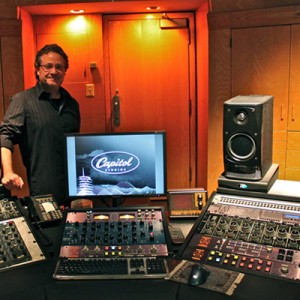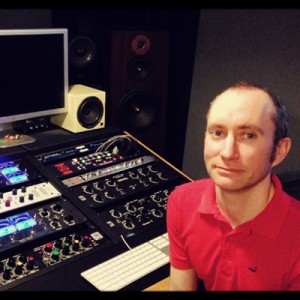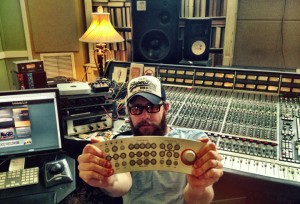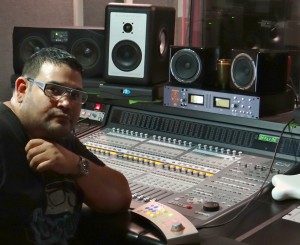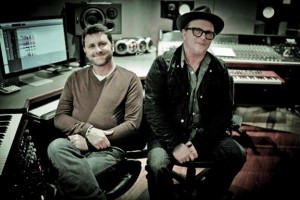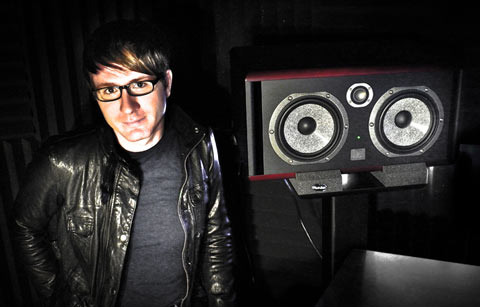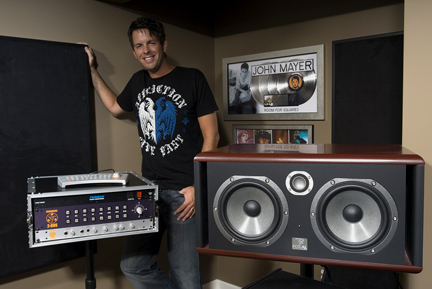Robert Vosgien Gets Dangerous
Famed Capitol Studios chooses a suite of Dangerous Music mastering gear to update studios
When Capitol Records Mastering in Los Angeles decided to replace the old “disc cutting” consoles originally designed for mastering vinyl, they began to try out several new transfer consoles including the Dangerous Music Master with its companion devices the Liaison and Monitor that combine to create a complete ‘mastering suite’. After extensive testing and listening, Dangerous Music was the final choice. Once the new gear was purchased and up and running in mastering engineer Bob Vosgien’s studio, Capitol made plans to do a remodel to his mastering room as well. Over the past 25 years of mastering, Vosgien has worked with top artists such as James Taylor, Bob Seger, Green Day, The Goo Goo Dolls, The Wallflowers, Selena Gomez, Bush, Chris Botti and No Doubt, among many others.
Read More »Mastering Engineer Nate Wood
Multi-instrumentalist on drums, bass & guitar, flies high playing live and engineering in the studio with Dangerous Music gear
The journey from being a musician to becoming a mastering engineer began with Nate Wood making his own album and preferring the approach of recording and mixing the music himself, compared to going to a studio and trying to get someone else to make his music sound the way he was hearing it. After mixing his own album and projects for friends he found a new companion career to his live performances in mastering other people’s projects. Based in New York, Wood has outfitted his studio with the Dangerous Music D-Box for monitor control, reference D/A conversion, and analog summing for his mix path, along with the Dangerous Liaison programmable analog router with parallel processing for his six key pieces of outboard gear, two compressors and four EQs. The Liaison proved to be an elegant solution to his tedious practice of hand re-patching outboard gear for mastering sessions.
Read More »Grammy-Winner F. Reid Shippen
Nashville based engineer wins two Grammys out of his seven 2012 award nominations and adds the BAX EQ to his extensive Dangerous Music gear setup
Junior Sanchez Gets Dangerous
Dangerous Music 2-Bus LT and Monitor ST are key studio ingredients in renowned producer’s Electronic Dance Music projects, as well as his R&B, Rock and Pop productions
Junior Sanchez started making records when he was in high school. Now from the stage looking out over a sea of people in the dance crowd at an Ibiza island festival as a DJ – along with the Swedish House Mafia’s Steve Angello – it seems that first teenage track was quite a while ago. Sanchez has evolved from using major studios and large format consoles in New York and LA to designing and building his own high-end studio in his New York area house. To get back to the sound he had mixing on analog consoles Sanchez has chosen Dangerous Music gear for mixing and monitoring. “I have the Monitor ST, the DAC ST and the 2-Bus LT. It’s changed the whole platform of how I hear, it’s awesome,” says Sanchez. “I live my life Dangerously.”
Read More »Richie Biggs & Charlie Peacock
Producers & Engineers Working in Busy Nashville Scene get “Consistency and Killer Sound” Mixing with Dangerous 2-Bus Analog Summing
When the Civil Wars took the stage at the 2012 Grammy® Awards, Dangerous Music was part of the moment, as the band’s highly successful and great-sounding record was mixed on the Dangerous 2-Bus. The duo’s live Grammy performance was spectacular, a combination of everything musical and emotional that musicians and music fans alike appreciate. Richie Biggs and Charlie Peacock are the engineers and producers behind the sound of the Civil Wars album “Barton Hollow.” They work around the clock on multiple projects in their Nashville studio and rely on the consistent recall capability and killer sound of the Dangerous 2-Bus analog summing amp and Dangerous D-Box summing and monitor control in their hybrid Pro Tools-based mix rooms.
Read More »FOH Engineer Horace Ward
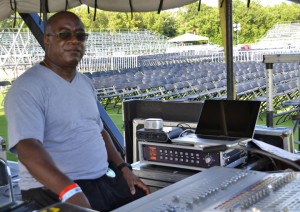
FOH engineer Horace Ward with the Dangerous Music 2-Bus summing amp (at right), mixing the Usher concert at the Moon Palace Resorts in Cancun, Mexico
Front of house engineer Horace Ward has a new secret weapon for making his live music mixes sound their best: the Dangerous Music 2-Bus. In the spirit of sharing, he’d like other engineers to know about it too, so their audiences can also get the best concert experience. The 2-Bus is best known for its role in the recording studio, bringing the tone, feel, and headroom of an analog console to digital mixes suffering from ‘in-the-box’ summing. But Ward has found a way to use the 2-Bus to get a similar enhancement – and control – over his live mixes. He says, “I don’t understand how the 2-Bus has been in the studio so long but hasn’t gotten to live shows – the sound is unbelievable.”
Read More »Pete Evick Mixes Bret Michaels
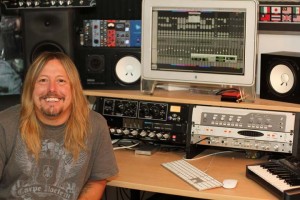 Engineer and Guitarist records and mixes hit records on the road for Rock & Roll Icon with Dangerous Music D-Box and Bax EQ
Engineer and Guitarist records and mixes hit records on the road for Rock & Roll Icon with Dangerous Music D-Box and Bax EQ
Pete Evick wears many musical hats. He’s the guitarist in the Bret Michaels Band, as well as Michael’s songwriting partner, (plus he has his own band: Evick); but he’s also the Bret Michaels Band engineer, and records and mixes while he’s on tour with them. Evick uses the Dangerous Music D-Box and Dangerous Bax EQ as key ingredients for his hit-record success and a killer rock sound. “The last two records we made both debuted in the top 40 Billboard charts, one at number 14, so they are legitimate hit records,” says Evick, “and they were impossible to do without the D-Box. That’s the whole point.”
Read More »Back in the Day: Silicon Valley & Music
As told to Linda Jacobson (lindaj@well.com)
LJ: Paul, what were you doing in 1984 — the year before you became a founding staff member of Opcode Systems? How would you describe the “work lifestyle,” routine, and group dynamic behind-the-scenes in your world then? Was the SF Bay Area audio industry back then influenced more by the cultures of the computer industry and Silicon Valley, music industry, San Francisco scene, and/or film industry and Hollywood?
PdB: In 1982 I had purchased a Rhodes Chroma synth and in 1983 created one of the first computer-based electronic music “home” studios in the San Francisco Bay Area around that instrument. I had added the Apple II computer and the sequencing and editing software from Fender along with the SIMPLE System synchronizer for video and audio and the requisite mixers, mics, speakers, 2-channel and multitrack tape decks. I was composing music for film and television and through my friend Doug McKechnie’s connection at Lucas Film I even had a chance to write a demo cue for the final Ewok scene in the latest Star Wars: Return of the Jedi movie, apparently Lucas wanted to hear some other ideas than what John Williams had come up with. Three of us in the San Francisco Synthesizer Ensemble got to write a sketch for the cue. It was exciting to see part of the movie before it came out.
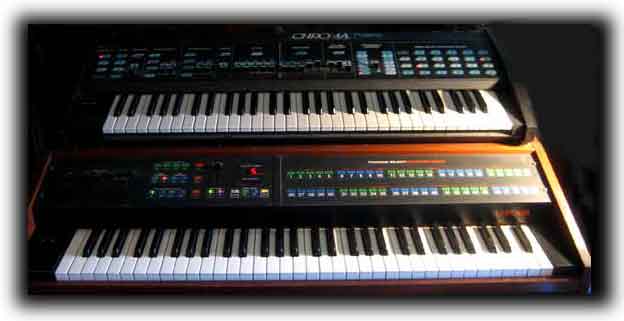
The Rhodes Chroma and Chroma Polaris
Adam Young of “Owl City”
Adam Young of “Owl City” Mixes on Focal Monitors
New chart-topping artist chooses Focal Twin6 Be monitors on breakout album ‘Ocean Eyes’
With a growing fan-base and a world tour that continues throughout 2010, Adam Young, the creative force behind the band “Owl City,” is taking off. His first independent release in 2008, ‘Maybe I’m Dreaming,’ received much praise and made Young into a phenomenon, with over 16 million profile views and over 80 million plays on MySpace, all stemming from posting a few songs from the year before.
That’s led to Owl City’s newest CD – ‘Ocean Eyes’ – released in 2009 by Universal Republic Records. The album has sold over 1 million copies in the U.S. alone, while the first single “Fireflies” hit #1 in 23 countries. During the making of the ‘Ocean Eyes’ album Young discovered Focal Twin6 Be monitors, then got himself a pair. “I absolutely love the Focals. I had mixed with other brands over the years, but it was always a bit deceiving. Other monitors seemed somewhat overly polished, bass heavy and even ‘clubby.’ The Focal Twin 6s are so transparent, but still easy to listen to and work with: they really help my mixes translate to anything I play them back on,” states Young.
Read More »Mix Engineer Jeff Juliano
Mixer Jeff Juliano Chooses FOCAL Monitors
Twin 6 Be Powered Monitors with Sub6 are now his Main Measure of a Mix
Mixer Jeff Juliano has used a lot of different speakers, and in the past 10 years he’s relied on the supposed ‘industry standard’ Yamaha NS10. But no more. Juliano recently tried the Focal Twin 6 Be powered monitors at his Delaware mixing studio and has now made them his number one choice. Having mixed a host of platinum-selling albums for artists such as Jason Mraz, Josh Kelly and Lifehouse, as well as John Mayer, who won a 2003 Grammy for his album “Room for Squares” which he mixed, Juliano has a great ear for sound, but was ready for the change.
“I’ve been going through so many speakers in my time mixing, I was an NS10 guy for so many years, and started to believe that was the only speaker in the world that mattered. The Focal Twin 6 Be monitors are the best that I’ve used in terms of studio-to-consumer listening translation for car stereos, clock radios — iPod ear buds, you name it. They really translate: what I hear in the studio is what the outside world hears, in my experience. When I go to the car and check a mix, it’s what I hear in the studio. That’s the end-all, that’s what matters,” stated Juliano.
Read More »
